Growing A String Of Pearls Plant: 10 Common Problems You May Have
Many indoor gardeners struggle with growing a String Of Pearls plant. Here are 10 reasons why you may be having problems with this hanging succulent and what you can do to fix the problems.
String Of Pearls, you’re downright fabulous growing both as a houseplant and in a container in the garden. I’ve grown them indoors and outdoors in different climate zones and find them easy to grow if the conditions/care is to their liking.
I want to share with you why growing a String of Pearls plant indoors can be a bit tricky so hopefully, this will help you to keep yours looking as beautiful as those strands around Audrey Hepburn’s neck in Breakfast At Tiffany’s.
I learned the botanical name as Senecio rowleyanus but you may see it called Curio rowleyanus. Besides String Of Pearls, another common name is String Of Beads.
This post may contain affiliate links, you can read our policies here.
Commons Problems with String of Pearls Plant Care
The most common signs that a String Of Pearls isn’t doing well are: stems and pearls are thinning out, pearls are shriveling, pearls are turning yellow, and the stems are dying.
One of our most popular blog posts (it’s an old one!) is on String Of Pearls so I get a lot of questions regarding this plant dying or not doing well. This hanging succulent can be hard to find and expensive in some areas so I want to dive in a bit further into this.
String Of Pearls Issues Indoors Video Guide
1. The soil is too heavy
Succulents need their soil mix to have excellent drainage and be well aerated. Some growers use the same soil mix straight across the board for all the plants they’re growing and that may be the mix yours came in. Or, perhaps you’ve used potting soil when repotting yours. Both could be too heavy and stay wet for too long or a String Of Pearls plant.
When I repot my String Of Pearls, I use this Succulent Soil & Cactus Mix Recipe. It’s good and chunky allowing the water to easily drain out. All my succulents both indoors and out love it.
it’s important that the pot has drainage holes so the excess water can readily flow out. If you don’t, this can lead to overwatering and eventually root rot.
If you’re using a store-bought succulent & cactus mix like this one, you might consider adding some pumice or perlite to further up the ante on the aeration and lightness factor. Here’s a good option that I’ve used in the past that is a gritty, fast-draining mix. It won’t need anything added to it.
I give most of my houseplants and succulents a light application of worm compost topped with a light layer of compost over that every spring. Easy does it – a 1/4″ layer of each for a 6″ String Of Pearls will be plenty. Read about my worm compost/compost feeding right here.
RELATED: I’ve done this general Guide to Repotting Plants geared for beginning gardeners which you’ll find helpful.
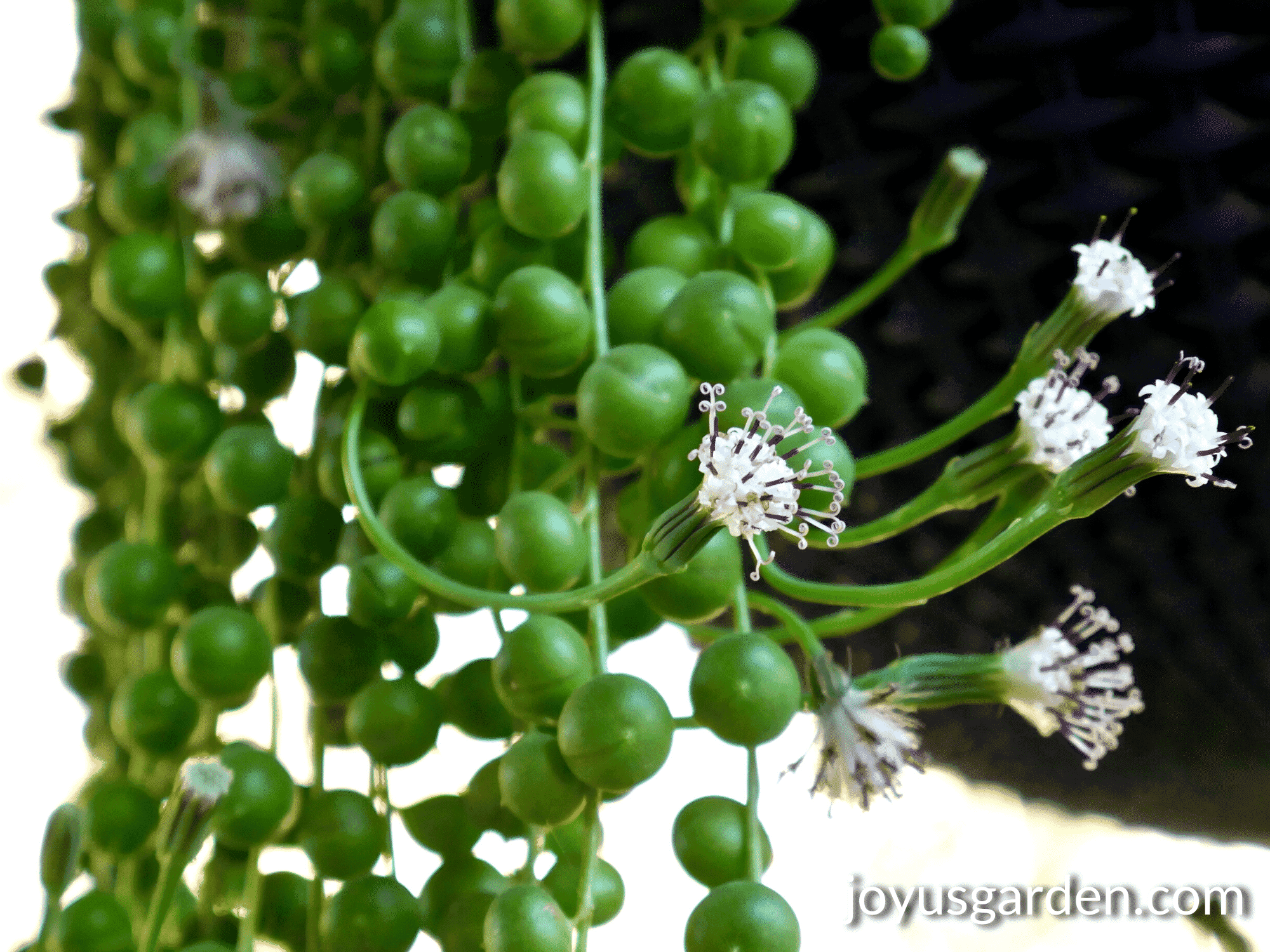
2. Too much fertilizer (too often; too heavy on the ratio) or the wrong fertilizer
This can cause fertilizer burn which leads to root damage. I’ve found that succulents don’t need a lot of feeding – just once in the spring and perhaps a repeat application if necessary in the mid-summer.
I feed mine indoors with the usual: a 1/2″ layer of worm compost topped with a 1/4″ layer of compost in the early spring.
I’ll mention worm compost again because it’s my favorite amendment. I use it sparingly as it’s quite rich. I’m currently using one made by a local company here in Tucson but I’ve also used Worm Gold Plus and Wiggle Worm.
The compost I use is also local and organic. Give Dr. Earth’s a try if you can’t find anywhere you live. Both worm compost and compost enrich the soil naturally and slowly so the roots stay healthy and the plants grow stronger. Happy roots, happy String Of Pearls!
If you have any liquid kelp or fish emulsion, these work fine too. I’m now using Max Sea and interchangeably with Eleanor’s VF-11 for all my houseplants a couple of times throughout the season. There are fertilizers formulated for succulents and cactus but I’ve never tried those. So, you have choices!
I live in the sunny Arizona desert so I now feed my succulents 3 times a year (besides the compost). When I live on the coast of California, it was 1-2 times a year.
Whatever you use, easy does it as succulents don’t require much or frequent feeding. For succulents such as a String Of Pearls, consider using the fertilizer or food at half the recommended strength as I do.
RELATED: Here’s my updated routine for Fertilizing Indoor Plants.
3. Frequent misting
Save misting for the air plants – they need it when growing in our dry home environments. Your String Of Pearls don’t as they’re native to the drier parts of southwest Africa and can handle lower humidity levels. Frequent misting of this plant, especially at the crown, is likely to lead to rot.
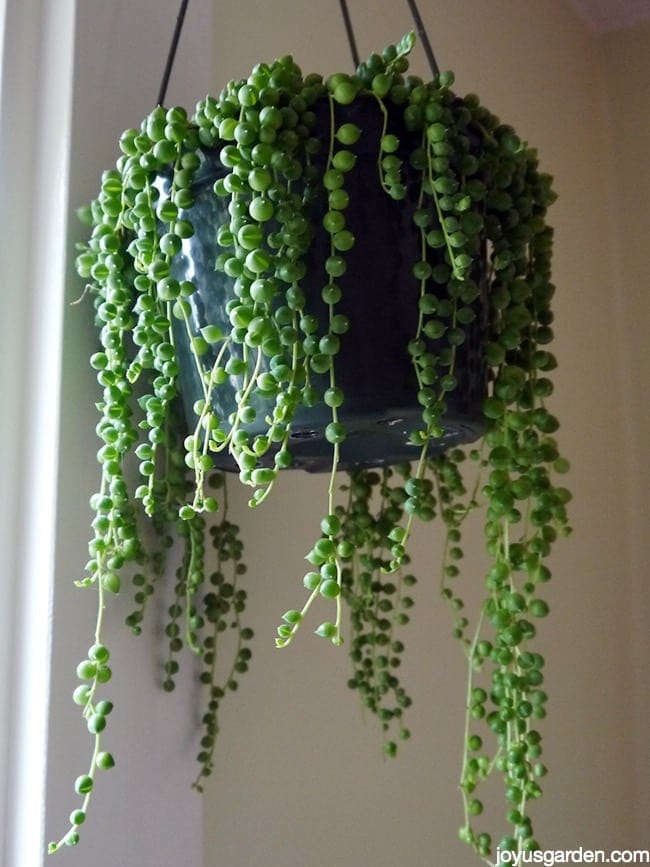
4. Your plant is in hot, direct sun
Keep your plant out of south or west windows. Especially in the summer months, the glass heats up which will cause a String Of Pearls to sunburn. It can be in the room with high light exposures but just make sure it’s 5-10′ away from the window (how far depends on your climate). Very bright, indirect light is their sweet spot.
As an example, here in the Arizona desert with lots of strong sun, a String Of Pearls plant would have to be 7-10′ away from south or west windows (even an east window in the hotter months). Mine is hanging in a large, north-facing window with great light but no direct sunlight.
5. No adjustment for the darker, cooler months
This is true of all houseplants as they rest a bit at this time. In winter, you may have to move your String Of Pearls to a brighter location in your home.
Also, be sure to back off on the watering frequency at this time.
If you water your plant every 7-14 days in the summer, then every 14-21 days in the winter months will probably be best. How warm you keep your house is also a factor.
HEAD’S UP: Here’s a Guide To Winter Houseplant Care which you might find useful.
6. It’s planted in a pot that’s too big
Pot size matters. A String of Pearls plant doesn’t have a big root system. Repotting 1 into a small pot is better than a big pot. For this reason, I repot mine every 5-7 years or so sometimes just to freshen the potting mix.
Planting one in a pot that’s too big can cause the soil to stay wet which leads to root rot. The majority of the slender stems at the crown resting on the wet mix will cause both them and the bead-like leaves to “mush out”.

These last 4 reasons are what I believe to be the most important
7. Not enough light
When growing outdoors, they need filtered light or bright shade. A String Of Pearls plant indoors needs strong natural light. A medium to high light exposure with no direct, hot sun is what they need to grow successfully.
Not enough light + too much water = bye-bye sweet hanging succulent.
By the way, I’ve found that a String Of Pearls houseplant is not a low light plant. It grows best in bright light.
HEAD’S UP: This guide as to How Much Sun Do Succulents Need will help you out.
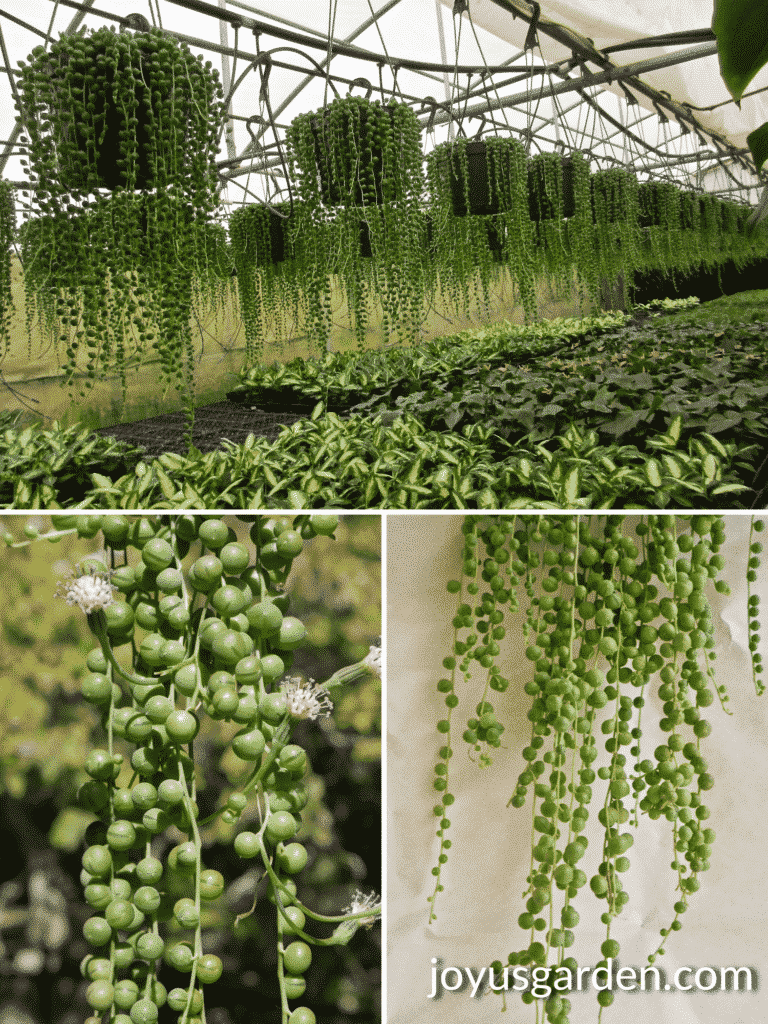
8. Planted too deep inside the pot
I’ve seen this many times where the crown of the plant has sunken down 1″ or more. This can cause the crown and stems to rot out because they stay too wet when aeration is decreased. Those thin stems rot out in no time.
It’s best if the crown of the plant is only 1/2 – 1″ below the top of the pot. If planted too deep, along with too much water, also = bye-bye.
Related: Answering Your Questions About Growing String Of Pearls
9. Too much water
This happens much more commonly than not watering enough. What I mean by this is watering too often. The roots of a plant need oxygen too and a mix kept consistently moist deprives them of this.
Simply put, ease up on the frequency of watering if yours is looking sad and mushy. You want the plant to go nearly or completely dry before watering again.
It’s hard for me to tell you often to water your String Of Pearls plant indoors because there are many variables that come into play. Here are a few: the pot size, type of soil it’s planted in, the location where it’s growing, and your home’s environment.
I’ll tell you how often I water my 6″ String Of Pearls here in Tucson. In summer it’s once a week and in winter every 2 weeks. Remember, I’m in a sunny climate with warm or hot temps for a good part of the year. Adjust for your climate.
You don’t want to keep the plant wet but on the other hand, you don’t want the soil mix to be dry for days. Those slender stems don’t hold as much water as other succulents do.
Here are a couple of common signs you’re watering too much or too little. Too much water: the pearls are brown and/or mushy. Also, the beads could shrivel. Too little water: the pearls and stems are dry. Also, the pearls shrivel. The shriveled pearls can be confusing because this happens in both cases.
HEAD’S UP: These posts on Watering Indoor Plants and How Often To Water Succulents will shed some light on this subject.
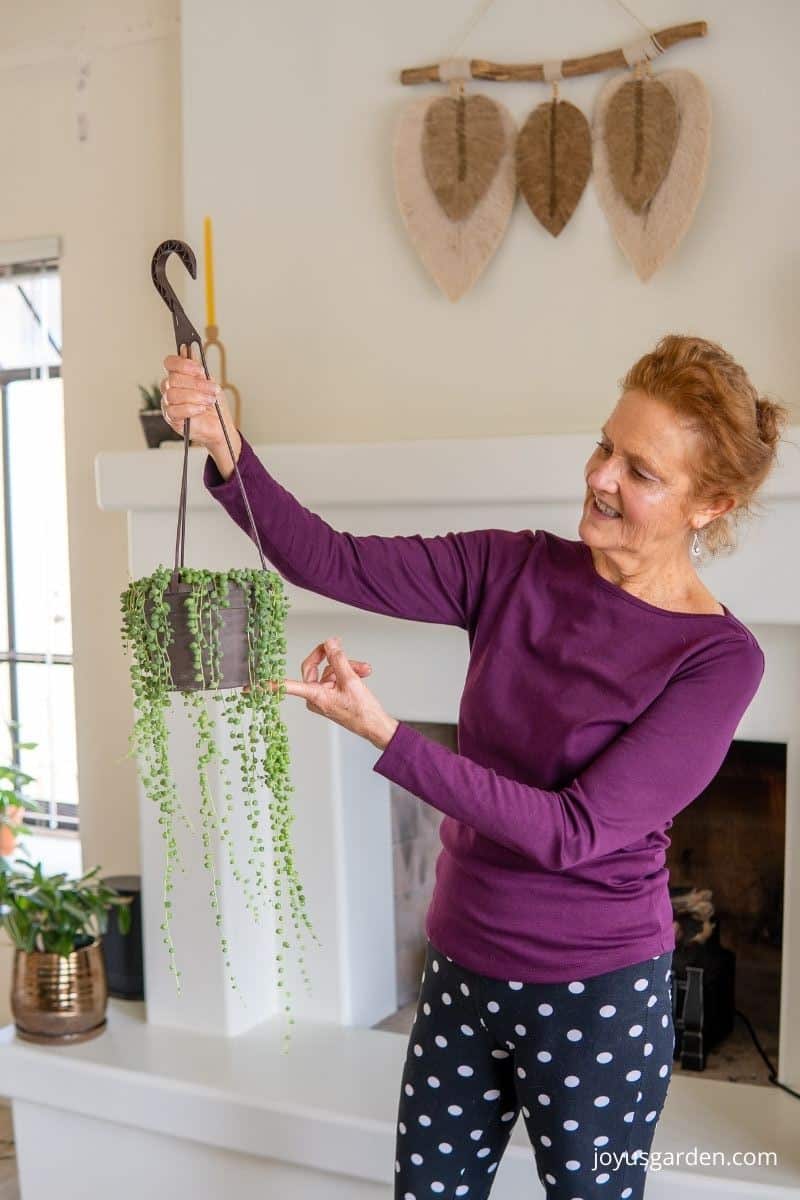
10. The plant was too wet when you bought it
If your String Of Pearls plant was soaked when you bought it (many big box stores and nurseries water their plants every day), it may never have gotten the chance to dry out. My friend lost a Pothos because of this.
Most pots have at least 1 drainage hole. Check to make sure yours does otherwise the water won’t flow out. I plant my succulents in pots with multiple drain holes so water building up won’t be an issue.
Every now and then, a drain hole gets blocked. You can open it back up with a chopstick, toothpick, knitting needle, etc.
If the soil isn’t drying out, you may have to repot your String Of Pearls plant into a more appropriate Succulent and Cactus Mix.
Want to learn more about How to Care for Succulents Indoors? Check out these guides!
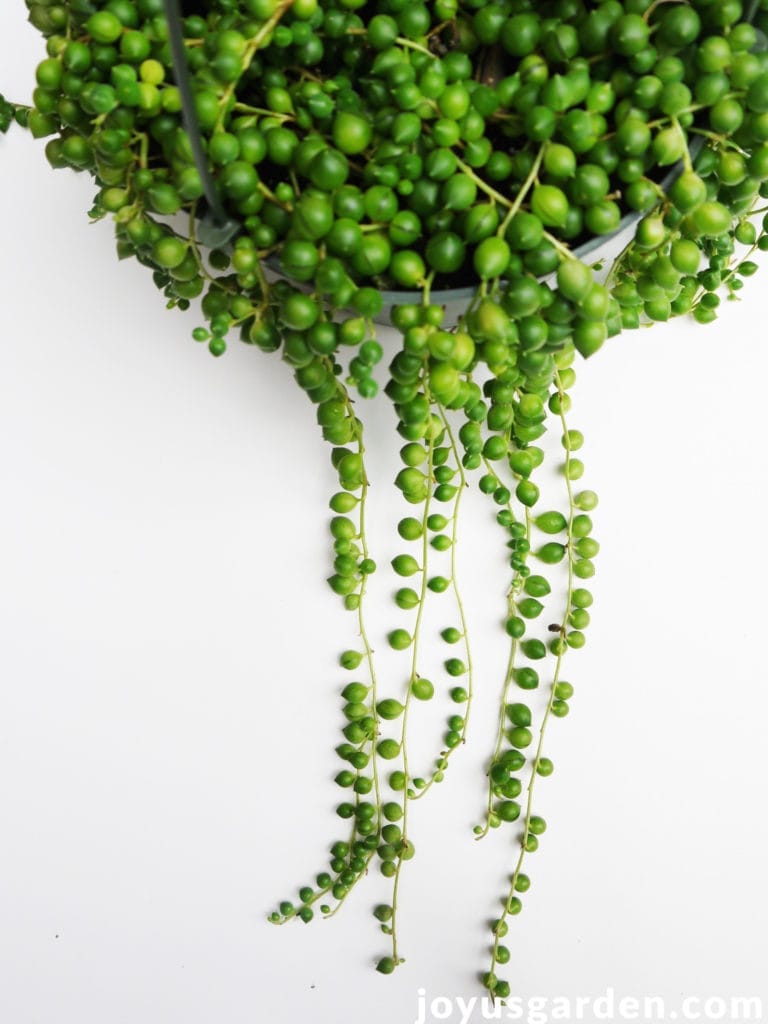
String Of Pearls definitely has character and seems to be loved here, there, and everywhere. If you’re looking to grow a String of Pearls plant indoors, I hope this helps keep yours healthy, happy, and looking good!
Happy gardening,


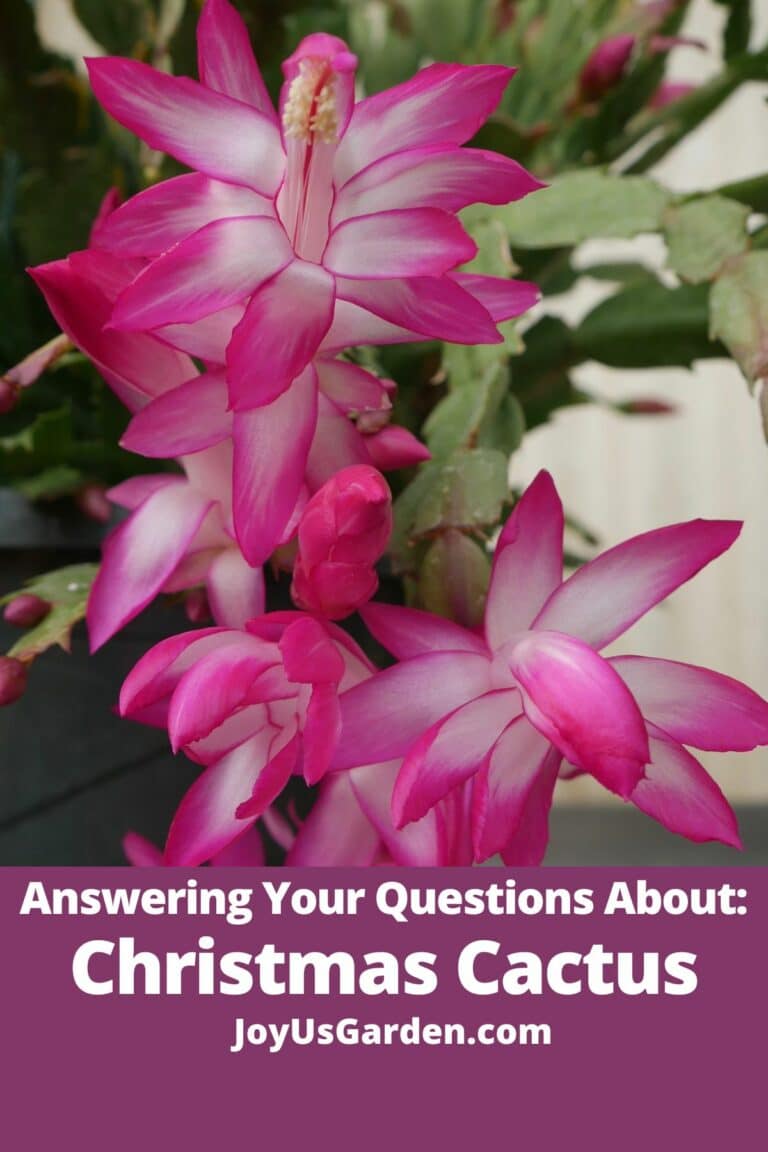
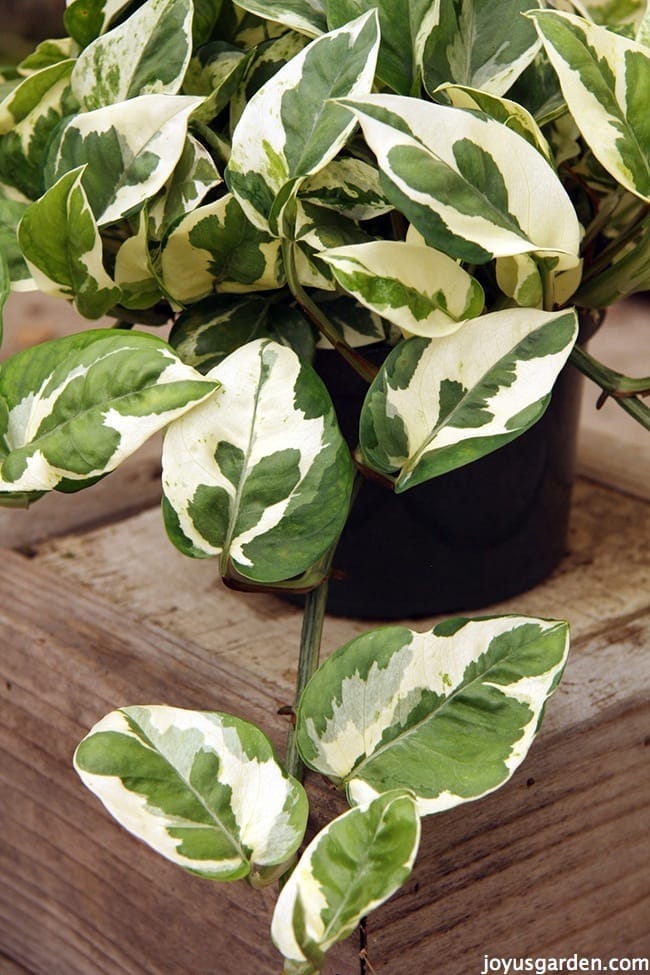

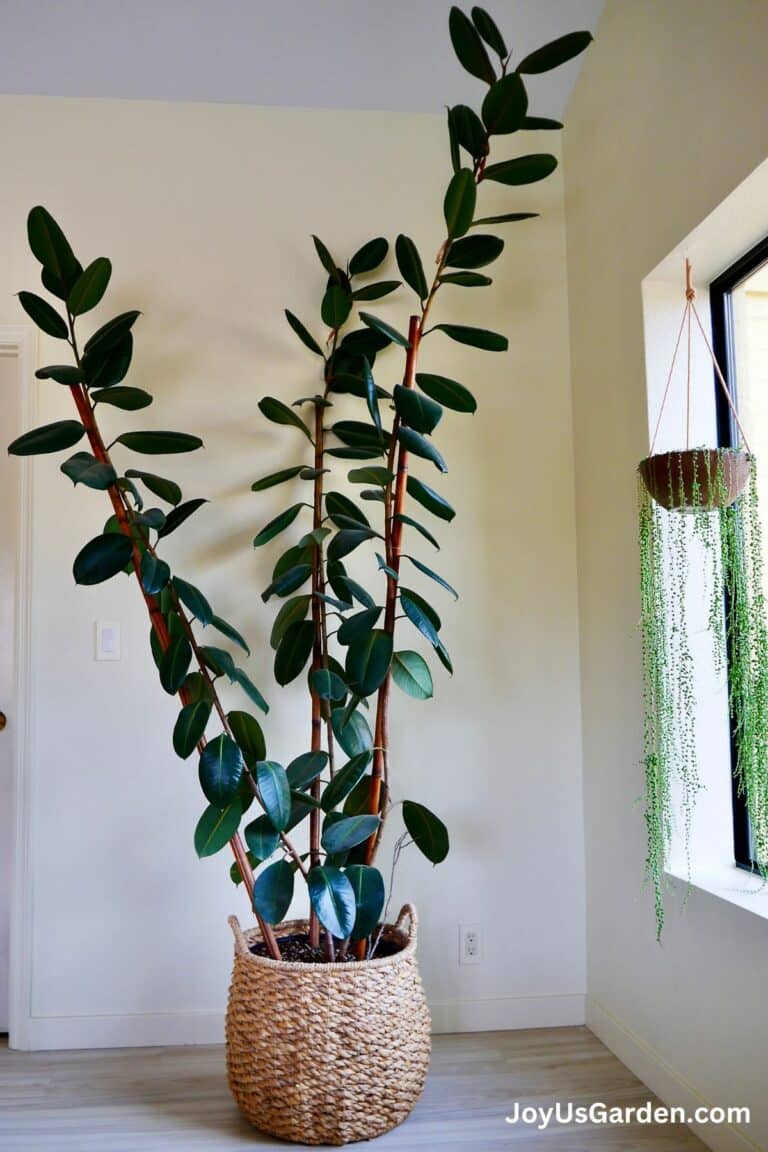

Ah, another post about string of pearls…you are a temptress, Nell. I’m going to have to get one of these beautiful plants. Thank you for your site and your posts! Your site and videos help me get through the long Minnesota winters!
Cindy – Oh, the String Of Pearls are the temptress not me! Many have problems with this plant & that’s why I wanted to do this post & video. I grew up in New England & recall thos snowy, cold winters well. Thank you for your kind words – remember, spring is just a week away! Nell
Hi! Calling in from Nashville TN ;). Just recently got a beautiful SOP plant, and I’m looking for the right pot to get for it. I’ve read your post and understand it needs to drain well, but I’m unsure of what size to get. The plant was purchased in a 6inch pot, not too deep (which sounds to be a good thing. Should I just leave it in that? It’s not too purty. Also getting a wall hanger so I can put it closer to my window (it won’t be directly in sunlight).
Hi Kelsey – I’ve found that the type of pot (terra cotta, plastic grow pot, etc) doesn’t matter too much with SOP. And, they don’t have an extensive root system so don’t rush to repot it unless roots are coming out of the drain holes. A succulent & cactus mix ix best for planting. Nell
Hi there! First of all, thanks for such informative posts. The less talented gardners of the world appreciate them.
Secondly, I’m growing a string of pearls near my window at the moment. I live in a temperate climate, but in the summer it does tend to get hot. Currently they’re not in direct sunlight, but I’m finding that some of the strands of pearls are drying up into hard brown dehydrated balls, while the rest of the plant seems to be doing well. I’m finding a few strands that also seem to be slightly shrivelled, and almost a darker green/blue colour. Does this strike you as an over or under watering situation… I’m currently watering about once a week.
Thank you so much!!
Emma
Hi Emma – Thank you! I try to explain things as clearly as possible because gardening, like anything, can be daunting at first. Many people struggle with SOPs so you’re not alone. Mine get the occasional shriveled up pearls & stems because of the dry climate I’m in along with very hight summer temps. Hard, dehydrated, green/blue sounds like too dry or they dried out for too long at 1 time (that’s all it takes!). I water mine 2x week in the summer but they grow outdoors in the AZ desert. A thorough watering once per week in summer should do it. Water less often in winter. Nell
Hi Nell, sadly my SOP just kaputed. I am confused by the warning about root rot, you and a lot of sites say prevent this by letting the soil dry out, but I just read this Instagram, who seem to suggest that SOP can flourish if left in a glass of water indefinitely. Can you help clarify?
httpss://www.instagram.com/p/BhpAQMrgTTO/?utm_source=ig_web_copy_link
Hi – I have never propagated 1 in water & have never seen it done. Neither have I grown 1 in water. I imagine their very thin stems would rot out. Nell
Hi Nell! Also from New England originally but I find myself in NW Montana. My house has great light for the most part and I’ve put my newly planted SOP in the south face window, hanging above the window line so it doesn’t get burnt. I bought it from a nursery in AZ and they mailed it with dry roots and I have it in black gold cacti mix in a terra cotta pot. I just drenched it in the sink and I’m wondering if I should move it to another window or try it outside for the next few weeks. Thanks in advance! 🙂
Hi Holly – If it’s above the window line, & not receiving any direct sun, it should be fine. Especially in the winter when you tend to be darker that far north. It’ll do well outdoors if it’s not getting direct sun & you bring it in before the temps drop. Nell
Hi Nell, I love your posts on these beautiful succulents, I think I read they all. I have been growing strong of tears for over a year. When I leave it outside, it grows beautifully. But when I bring it indoors, the stems always seem to attract aphids. I tried spraying with isopropyl alcohol like you mentioned. It killed that batch but after a week another batch developed. I tried dish soap mixed with water, I tried neem oil. They all did not work and I end up the whole plant practically dying. I cut the good stems off, propagate in a new pot and leave them outside (by this time the weather has warmed up). They grow well until I have to bring them inside. How can I get rid of aphids on these jewels for good?
Hi Jane – Thank you for reading this blog! Sorry to tell you, but aphids appear every year. There may actually be an aphid or 2 hidden on the plant & you’re bringing it inside. In my experience, aphids are most prevalent in the spring. I’d give the plant a preventative spraying (at 1/2 strength) before you bring it inside each year & see if that works. Nell